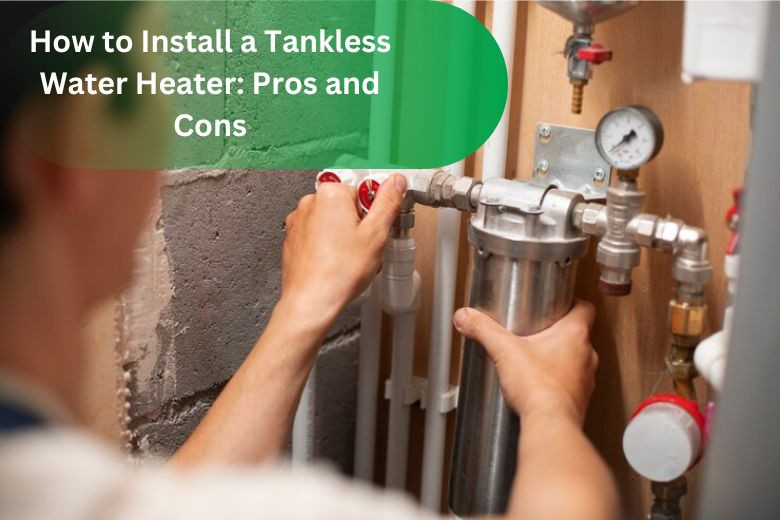How to Install a Tankless Water Heater: Pros and Cons
Posted on September 20, 2024 by Admin

Most people now switch to tankless water heaters because they really save space and are efficient. Knowing how to install a tankless water heater will help in decision-making, and being aware of the associated pros and cons will be very important. An Electrician Service Provider can assist with proper installation, ensuring safety and efficiency. Let us get into the basic steps of installation and some of the benefits and drawbacks associated with this very popular option in water heating.
How to Install a Tankless Water Heater: A Step-by-Step Guide
1. Assess Your Needs
Measure the quantity of hot water your family is going to use before installing a tankless water heater. By doing so, you will know what size and capacity the tankless water heater you need is. This will be determined by the number of bathrooms, appliances used, and simultaneous hot water usages.
2. Choosing the Right Location
Choose the right location for the successful installation of your unit. Tankless water heaters can be installed either in an indoor or outdoor location. Make sure it has enough ventilation and is accessible to easy servicing. With regard to indoor installation, make sure that the mounting is against a very sturdy wall and that there is enough clearance around the unit.
4. Gather Needed Tools and Materials
It will require some tools and materials, including a tankless water heater unit, mounting hardware, piping, a venting system, and electrical wiring. Be sure to have all the components available before commencing the installation.
4. Mount the Unit
Mount the tankless water heater to the wall using the brackets and hardware provided by the manufacturer. Connect the water lines to the heater. Be sure that you have correct pipes and fittings for the proper process; otherwise, you will face a leakage problem. In this step, carefully follow all the instructions given by the manufacturer.
5. Connect the Venting System
The venting of a tankless water heater shall be so arranged as to provide for safe disposal of the exhaust gasses. Vent the unit in accordance with the manufacturer's instructions. Be sure that all connections are securely tightened and the vent system complies with local building codes.
6. Electrical and Gas Connections
For gas models, attach the gas supply to the unit. Make sure the gas line is sealed correctly and there are no leaks. For electric models, attach electrical wiring to the unit, following all safety precautions. Note that connections in these areas need to only be made by a licensed electrician or plumber in keeping with local codes.
7. Test the System
Now that everything is connected, turn on the water and power. Test the system by running some hot water from the faucets and checking for leaks. Adjust the temperature settings as per your requirement from the unit itself and verify that everything is working according to your demand.

Pros and Cons of Installing a Tankless Water Heater
Pros:
1. Energy Efficiency:
Tankless water heaters heat only when needed, using significantly less energy than traditional tank heaters, thereby providing both lower utility bills and a reduced carbon footprint.
2. Space Saving:
Tankless water heaters are compact units that mount on the wall, freeing floor space in your home especially for small spaces.
3. Continuous Hot Water:
Since tankless heaters are on demand, you will never run out of hot water; hence, this makes them ideal appliances for large homes that consume a lot of water.
4. Longer Service Life:
As a rule, tankless water heaters generally outlive conventional models equipped with tanks. Most of them live for over 20 years or so if well-maintained.
Cons:
1. Higher Upfront Cost:
In most instances, the price for a tankless water heater and installation is almost always higher when compared to that of a conventional tank water heater.
2. Complexity in Installation:
A tankless water heater's installation can sometimes be tricky because you may need to upgrade either your electrical or gas systems. This should only be installed by professionals.
3. Low Flow Rate:
You can't draw enough water with tankless water heaters, if multiple outlets run simultaneously. This happens if you have a unit that is too small for your household's needs.
4. Requirements of Maintenance:
Yes, some degree of maintenance is required to be performed in the case of tankless water heaters for them to work at their best. Periodically, descaling should be performed to remove the buildup of minerals.
Conclusion
Knowing how to install a tankless water heater and all its associated pros and cons fundamentally forms two very critical steps toward making the right decision. Though tankless water heaters bring with them many benefits in terms of energy efficiency and space conservation, they still bear higher upfront costs and are sometimes tricky to install. Consulting an Electrician Service Provider can help ensure a smooth and safe installation process. It will then be easier to identify whether the tankless water heater is a prudent decision for a house if needs are carefully considered and the professional consultation goes well.
Also Read :
The Benefits of Professional Drain Cleaning vs. DIY Methods
How to Prevent Water Damage in Your Home
How to Integrate Home Automation Systems with Existing Electrical Systems
How to Finance Your Roof Replacement: Loans, Grants, and Insurance
Roof Safety Tips for Homeowners
The Impact of Algae and Moss on Your Roof
How to Deal with Roof Leaks During a Storm
How to Create an Electrical Maintenance Plan for Your Home
Faqs
-
1. How does a tankless water heater work?
It warms the water when it passes through the unit; it doesn't need any storage tank. As a result, you will receive a continuous flow of hot water.
-
2. What is the benefit of installing a tankless water heater?
Energy efficiency, space-saving, unlimited hot water, and longer life compared to the normal tank water heaters.
-
3. What should I consider prior to installation?
The demands of your family for hot water, your preferred installation site, and if you need electrical or gas system upgrades in the sake of supporting the tankless unit.
-
4. Will I need to professionally install the tankless water heater?
This would call for professional installation to ensure that everything is properly set up, more so with gas or electrical connections, and to meet the local building codes.
-
5. How is a tankless water heater maintained?
Regular maintenance will include descaling the unit to prevent mineral buildup, checking for leaks, and ensuring proper ventilation to maintain optimal performance.
Recent Post
- Top Plumbing Service Providers in Arizona, USA
- Top 10 Electrician Service Providers in Alabama, USA
- Top 20 Roof Repair Service Providers in Alabama, USA
- The Role of Roof Insulation in Energy Efficiency: Tips and Tricks
- Understanding Roof Damage from Wildlife and How to Prevent It
- How to Choose the Best Roofing Contractor for Emergency Repairs
- Roofing Maintenance for Historic Homes: Preserving Architectural Integrity
- The Importance of Proper Attic Ventilation for Roof Health
- How to Identify and Prevent Roof Mold and Mildew
- The Best Practices for Removing Snow from Your Roof